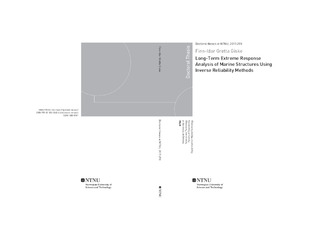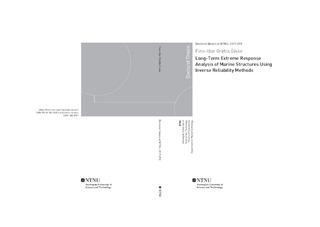| dc.contributor.advisor | Leira, Bernt | |
| dc.contributor.advisor | Øiseth, Ole | |
| dc.contributor.author | Giske, Finn-Idar Grøtta | |
| dc.date.accessioned | 2018-03-22T12:42:49Z | |
| dc.date.available | 2018-03-22T12:42:49Z | |
| dc.date.issued | 2017 | |
| dc.identifier.isbn | 978-82-326-2665-6 | |
| dc.identifier.issn | 1503-8181 | |
| dc.identifier.uri | http://hdl.handle.net/11250/2491725 | |
| dc.description.abstract | For the assessment of extreme responses needed in design of marine structures, a full long-term analysis is recognized as the most accurate approach. However, due to the very large number of structural response analyses traditionally needed for this approach, the computational effort is usually considered to increase above acceptable levels for complex structures, e.g. floating bridges. In this work, an effort is made towards more efficient, yet accurate, full long-term analyses.
This thesis is written as a collection of four papers, where each paper is either published or submitted for journal publication. In the first paper, a new method is presented for efficient calculation of auto- and cross-spectral densities in the stochastic modelling of ocean waves and wave loads. As part of the short-term response analyses, the method contributes to more efficient long-term response prediction. In the second paper, an exact and an approximate formulation for the long-term extreme response of marine structures are discussed and compared. A new method is proposed for the numerical solution of the exact formulation, based on an inverse first order reliability method (IFORM). In the third paper, the IFORM approach is further developed, and the accuracy of the long-term extreme response approximation is improved, using an inverse second order reliability method (ISORM) approach. Finally, in the fourth paper, the developments of the first three papers are demonstrated for a long-span pontoon bridge subjected to wave loads, revealing that characteristic values of the long-term extreme response can indeed be calculated in an efficient manner. Especially the ISORM approach is seen to provide high accuracy, using only a reasonable amount of short-term response calculations.
Hopefully, the contributions of this work will make full long-term extreme response analyses more attractive and available for the practical design of marine structures. | nb_NO |
| dc.language.iso | eng | nb_NO |
| dc.publisher | NTNU | nb_NO |
| dc.relation.ispartofseries | Doctoral theses at NTNU;2017:298 | |
| dc.relation.haspart | Paper 1:
Giske, Finn-Idar Grøtta; Leira, Bernt Johan; Øiseth, Ole.
Efficient computation of cross-spectral densities in the stochastic modelling of waves and wave loads. Applied Ocean Research 2017 ;Volum 62. s. 70-88.
The published version is available at
https://doi.org/10.1016/j.apor.2016.11.007 | |
| dc.relation.haspart | Paper 2:
Giske, Finn-Idar Grøtta; Leira, Bernt Johan; Øiseth, Ole.
Full long-term extreme response analysis of marine structures using inverse FORM. Probabilistic Engineering Mechanics 2017 ;Volum 50. s. 1-8
The published version is available at
https://doi.org/10.1016/j.probengmech.2017.10.007 | |
| dc.relation.haspart | Paper 3:
Giske, Finn-Idar Grøtta; Leira, Bernt Johan; Øiseth, Ole.
Long-Term Extreme Response Analysis of Marine Structures Using Inverse SORM.
Journal of Offshore Mechanics and Arctic Engineering -
Is not included due to copyright restrictions available at
http:doi.org/10.1115/1.4039718 | |
| dc.relation.haspart | Paper 4:
Giske, Finn-Idar Grøtta; Kvåle, Knut Andreas; Leira, Bernt Johan; Øiseth, Ole.
Long-term extreme response analysis of a long-span pontoon bridge. Marine Structures 2018 ;Volum 58. s. 154-171
The published version is available at
https://doi.org/10.1016/j.marstruc.2017.11.010 | |
| dc.title | Long-Term Extreme Response Analysis of Marine Structures Using Inverse Reliability Methods | nb_NO |
| dc.type | Doctoral thesis | nb_NO |
| dc.subject.nsi | VDP::Teknologi: 500::Marin teknologi: 580 | nb_NO |
| dc.description.localcode | Digital full text not available | nb_NO |

